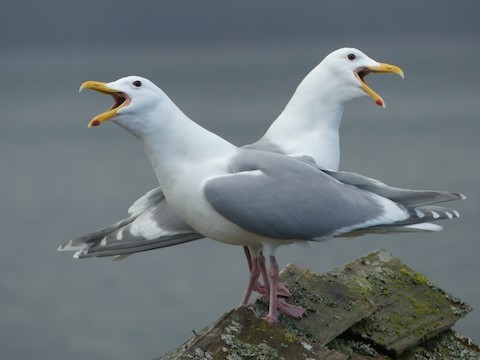Birdfinding.info ⇒ Common and conspicuous along North Pacific coasts from Alaska south to Hokkaido and central California. Uncommon south to South Korea, Honshu, and Baja California. Especially numerous along the northwestern coast of North America, including the downtown districts of Seattle, Vancouver, and Victoria.
Glaucous-winged Gull
Larus glaucescens
North Pacific coasts, islands, and adjacent waters of Asia and North America. Mainly in coastal habitats, but also ranges inland locally along river systems with salmon runs and in settled areas with concentrations of edible refuse.

Approximate distribution of the Glaucous-winged Gull. © Xeno-Canto 2022
Breeding. Nests colonially on cliffs and islands from the Seward Peninsula south throughout the Bering Sea region, along the Kamchatka Peninsula and Kuril Islands to Hokkaido, and in North America east along the southern coast of Alaska and south to Oregon.
Small numbers regularly occur in summer westward around the Sea of Okhotsk and north to the vicinity of Point Barrow, Alaska, and inland along rivers of Alaska, the southwestern Yukon, British Columbia, and the Pacific Northwest. More exceptional northeast into the western Canadian arctic (multiple records each from Herschel Island, Inuvik, and Yellowknife).

North American Breeding Bird Survey Abundance Map: Glaucous-winged Gull. U.S. Geological Survey 2015
Nonbreeding. Winters mainly along coasts from the Bering Sea and Sakhalin south in the west to central Honshu, and in the east to northern Baja California. Also winters at many inland locations, mainly along rivers, in the Pacific drainages of Alaska, British Columbia, the Pacific Northwest, and the Central Valley of California.
Small numbers regularly winter west to the Korean Peninsula and Kyushu. There are just a handful of records from China (one from Shanghai and two from Hong Kong).
Apparently annual in small numbers south to Hawaii, the southern tip of Baja California and the southern portion of the Gulf of California. Roughly annual southeast to the Salton Sea and the northern end of the Gulf of California. There are isolated records of vagrants from Johnston Atoll, Isla Socorro, Mazatlán, and Cihuatlán (Jalisco).
In fall and winter, wanderers sometimes appear at scattered inland locations east to the Great Lakes, the central Mississippi Valley, and the southwestern U.S., exceptionally east to St. John’s, Newfoundland, and Allentown, Pennsylvania.
Trans-Atlantic vagrants have also been documented on multiple occasions, with records from the Canary Islands (El Hierro), Iceland, Ireland, England, Morocco, Norway, and Wales.
Identification
A large, pale-mantled gull with pink legs and gray wingtips that is widely predominant along cold temperate coasts of the North Pacific. Among large gulls, it is more distinctive than most, but a tendency to hybridize with several species results in many ambiguous individuals that may or may not be first-generation hybrids or partial hybrid progeny.

Glaucous-winged Gull in breeding plumage. (Port Chalmers, Montague Island, Alaska; May 12, 2015.) © Brooke Miller
Adult Plumages. Adults have a pale-gray mantle, similar in tone to other large, pale-mantled Larus gulls.
Unlike its relatives, adult Glaucous-winged has gray wingtips that do not contrast sharply with the mantle. The wingtips have a subtle pattern that resembles that of the Herring-type gulls, but is either the same shade of gray as the mantle or slightly darker and duller. Typically shows a single large white “mirror” at the tip of the outermost primary. When folded, the primaries may be noticeably darker than the mantle.

Glaucous-winged Gull in flight, showing typical gray wingtip pattern. (Qualicum Bay, British Columbia; March 6, 2022.) © Blair Dudeck
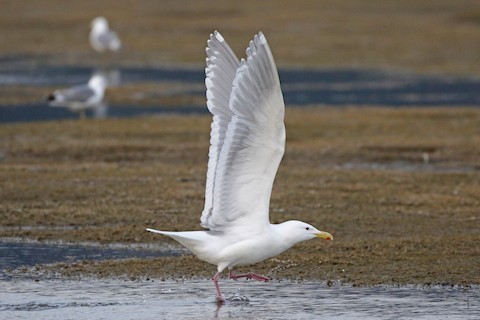
Glaucous-winged Gull in breeding plumage, showing the wingtip coloration and pattern on the upperside and underside. (Lake Laberge, Yukon; June 5, 2017.) © Cameron Eckert
The bill is long, heavy, and bulbous in profile, with a distinct angular projection near the tip of the lower mandible.
The irises of adults are usually dark brown overall, but some have either pale or intermediate eyes.
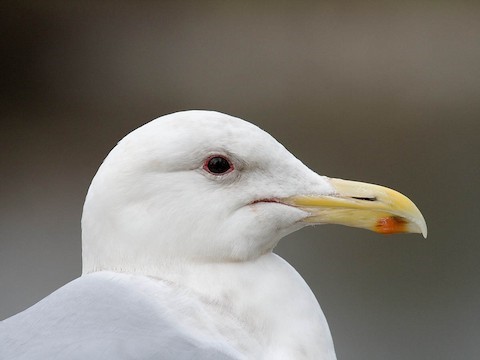
Glaucous-winged Gull, close-up. (Commonwealth Lake Park, Cedar Hills, Oregon; February 17, 2009.) © Greg Gillson
Nonbreeding adults typically develop extensive grayish-brown smudging over most of the head and neck, often appearing as a complete hood. On most individuals the smudging is faint, but on a few it can become dark-gray.
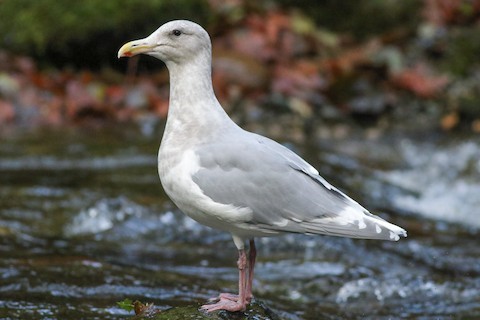
Glaucous-winged Gull in nonbreeding plumage, showing typically extensive, but faint, smudging throughout its head and neck. (Goldstream Provincial Park, British Columbia; November 4, 2020.) © Sean McElaney

Glaucous-winged Gull in nonbreeding plumage, showing typical pattern, but darker than most, including the mantle, primaries, and extensive smudging on its head and neck. (Cama Beach State Park, Camano Island, Washington; February 9, 2020.) © Anthony Gliozzo
The overall tone and darkness of the gray coloration vary somewhat, both within and among regional populations of Glaucous-winged Gulls. Asian populations from the Commander Islands south apparently average darker than the North Americans.
Immature Plumages. Most juvenile Glaucous-winged are ginger-brown overall, but vary from pale sandy-beige to medium-brown. Some individuals are more grayish. (For examples of various immature plumages, see the “more images” section below.) The juvenile plumage is distinctly spotted and mottled, but this pattern quickly wears away.
Immature Glaucous-winged Gulls have all-black bills (unlike immature Glaucous Gulls, which sometimes have similar plumage but always have distinctly bicolored, black-tipped bills).

Glaucous-winged Gull, an apparently typical juvenile. (Long Beach, California; November 19, 2021.) © Will Sweet

Glaucous-winged Gull, first-winter plumage, darker and browner than average. (Bodega Bay, California; January 10, 2020.) © Matt Davis
Compared to immature plumages of similar Larus gulls, Glaucous-winged is generally the most uniform in tone, with very little contrast—for example, the rump and tail are approximately the same color, whereas most other immature Larus have dark tails and pale rumps.
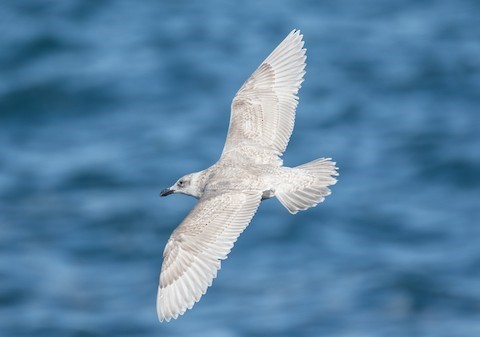
Glaucous-winged Gull, first-winter plumage—a bit paler than average—showing overall uniformity of color and tone, including the tail and flight feathers. (Point Pinos, California; January 31, 2018.) © Blake Matheson
The flight feathers are generally paler and more uniform than on other immature Larus gulls.
First-winter birds are mostly pale-brown overall, with decreased mottling.

Glaucous-winged Gull, first-winter plumage, showing overall uniformity of color and tone, including the tail and flight feathers. (Whitehorse, Yukon; April 11, 2016.) © Cameron Eckert
First-summer and second-winter birds show progressively more pale-gray on the mantle and generally retain pale brownish or grayish coloration throughout the underparts.
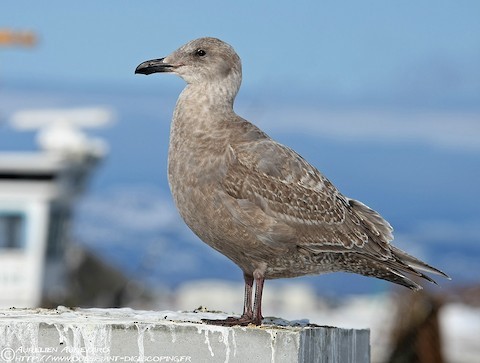
Glaucous-winged Gull, likely first-winter. (Shibetsu, Hokkaido, Japan; February 10, 2010.) © Audevard Aurélien

Glaucous-winged Gull, likely second-winter. (Port Hueneme, California; December 10, 2016.) © David Plotkin
Subadult Plumages. Subadults from second-summer to third-winter resemble adults, but usually show some gray or pale-brown in the tail, and a brownish tone on parts of the primaries.
The bill changes from all- or mostly black to mostly pale with black near the tip.

Glaucous-winged Gull, likely second-summer—a notably pale individual. (Ediz Hook, Port Angeles, Washington; July 13, 2021.) © Henrey Deese

Glaucous-winged Gull, likely third-winter—a notably dark individual. (Westport, Washington; November 8, 2021.) © David True
As with adults, winter subadults vary in the amount of grayish-brown smudging they develop over the head and neck.
By the third winter, subadults resemble adults, but with a black subterminal ring on the bill and traces of gray in the tail.
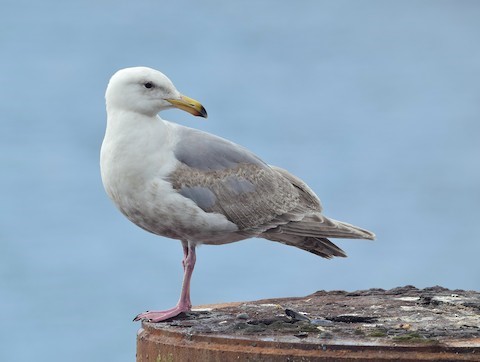
Glaucous-winged Gull, likely third-summer. (Science World, Vancouver, British Columbia; May 25, 2019.) © Sunny Zhang
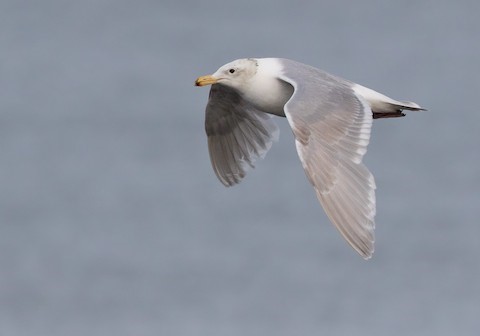
Glaucous-winged Gull, likely third-summer. (Anchor Point, Alaska; June 2, 2016.) © Lars Petersson
Hybrids and Other Variants. Some Glaucous-winged Gulls have darker-than-average wingtips that may appear either dark-gray or blackish. The prevalence of such individuals varies regionally. They appear to be most numerous toward the southern part of Glaucous-winged’s range on both sides of the Pacific: especially Hokkaido and the Pacific Northwest.
Many of these are first-generation hybrids between Glaucous-winged and either Slaty-backed, American Herring, or Western Gulls. Mixed pairs of Glaucous-winged and Western are common at colonies in Washington and Oregon, and their hybrid offspring are numerous south to central California.
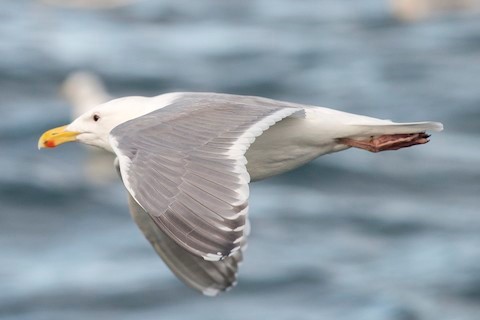
Probable Glaucous-winged-x-Western-Gull hybrid. (Offshore from Port Townsend, Washington; February 26, 2017.) © Bernardo Alps
Notes
Monotypic species.
See below for a comparison of the Glaucous-winged Gull with “Kumlien’s Gull”.
Cf. “Kumlien’s Gull”. The Glaucous-winged Gull is distinctive among large gulls in having gray wingtips that approximately match the coloration of the mantle. The only other Larus that shows approximately the same wingtip pattern and coloration is “Kumlien’s Gull”, the highly variable form that breeds in the eastern Canadian arctic and winters along the Atlantic coast of North America. Both are largely marine but occasionally wander to the interior of North America, and have been recorded as vagrants in one another’s coastal ranges.
Size: Glaucous-winged averages larger than “Kumlien’s”, and typically has a thicker bill and more angular head profile—whereas “Kumlien’s”, like “Thayer’s”, has a more rounded, dove-like head. However, Glaucous-winged is known for being especially variable in size, and some individuals may present a head-shape similar to that of “Kumlien’s”.
Wingtip Pattern: Glaucous-winged has largely gray wingtips that typically appear either concolor with the mantle or slightly darker, sometimes tending toward blackish (but washed-out). “Kumlien’s” varies widely, which makes generalizations difficult, but it usually shows noticeable contrast within the wingtip: i.e., the outer webs contrast with the inner webs, creating a dark-striped appearance.

“Kumlien’s Gull”, L. g. kumlieni, showing typical striped wingtip pattern. (State Line Beach, Winthrop Harbor, Illinois; February 15, 2020.) © Ryan Sanderson
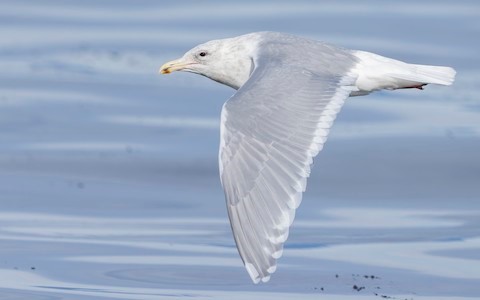
Glaucous-winged Gull, showing typical wingtip coloration and pattern. (Qualicum Bay, British Columbia; March 6, 2022.) © Blair Dudeck
Immature Plumages: Juvenile, first-winter, and first-summer plumages of both Glaucous-winged and “Kumlien’s” vary from pale ginger-brown to medium-brown overall and typically show little contrast in coloration throughout their plumage. Both have all-black bills. Some individuals may be identifiable by general coloration—in particular, many immature “Kumlien’s” are paler than any Glaucous-winged—but they overlap widely. In many cases, the most apparent distinction between their plumages is the degree of contrast, usually most noticeable between the rump and tail. Glaucous-winged is more consistently uniform; “Kumlien’s” usually shows some contrast between a darker tail and a paler rump. (Note that the immature “Thayer’s Gull” also shows noticeable contrast between a darker tail and a paler rump.)
More Images of the Glaucous-winged Gull

Glaucous-winged Gull in breeding plumage. (Stillwater, British Columbia; July 11, 2017.) © Lorenzo Vinciguerra

Glaucous-winged Gull in nonbreeding plumage. (False Creek, Vancouver, British Columbia; October 12, 2017.) © Jesse Anderson
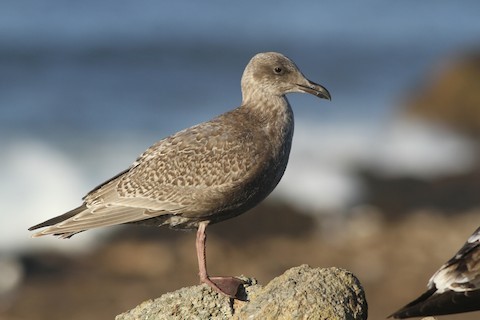
Glaucous-winged Gull, juvenile. (Southeast Farallon Island, California; October 27, 2020.) © Evan Lipton

Glaucous-winged Gull, juvenile. (Neah Bay, Washington; November 16, 2017.) © Joshua Covill

Glaucous-winged Gull, first-winter. (Lake Balboa, Sepulveda Basin Recreation Area, Los Angeles County, California; January 6, 2018.) © Kimball Garrett

Glaucous-winged Gull, first-winter. (Shoreline Park, Port Moody, British Columbia; January 14, 2018.) © John Reynolds
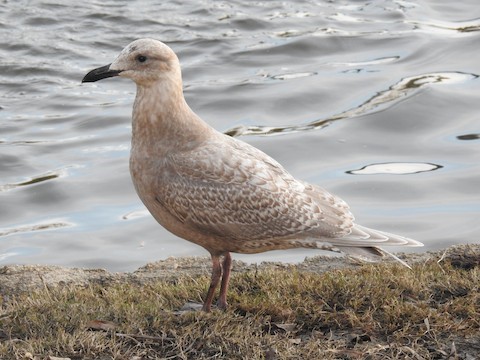
Glaucous-winged Gull, first-winter. (Polliwog Park, Manhattan Beach, California; January 8, 2022.) © Layton Pace

Glaucous-winged Gull, first-winter. (Lost Lagoon, Stanley Park, Vancouver, British Columbia; February 1, 2020.) © Douglas Faulder

Glaucous-winged Gull, first-winter bird with an unusually pale—but still all-dark—bill. (Kailua Beach Park, Oahu, Hawaii; February 11, 2019.) © Eric VanderWerf
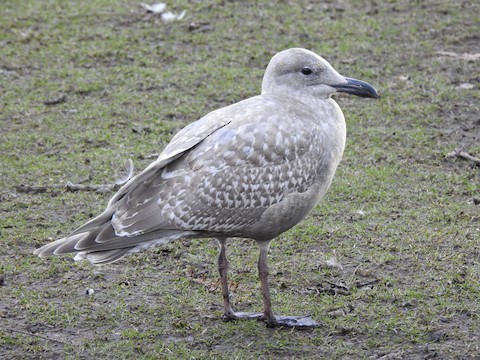
Glaucous-winged Gull, first-winter. (Beacon Hill Park, Victoria, British Columbia; February 11, 2020.) © Jody Wells

Glaucous-winged Gull, first-winter. (Goldfish Point, La Jolla, California; March 26, 2021.) © Alison Davies
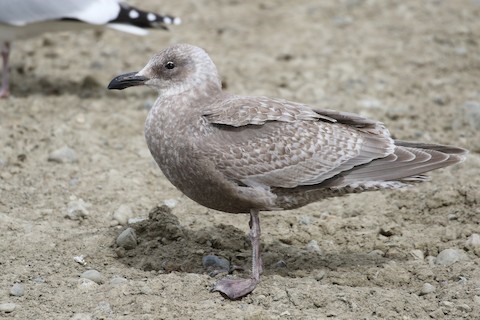
Glaucous-winged Gull, first-winter. (Whitehorse, Yukon; April 11, 2016.) © Cameron Eckert

Glaucous-winged Gull, first-summer. (Seward, Alaska; June 4, 2016.) © Lars Petersson
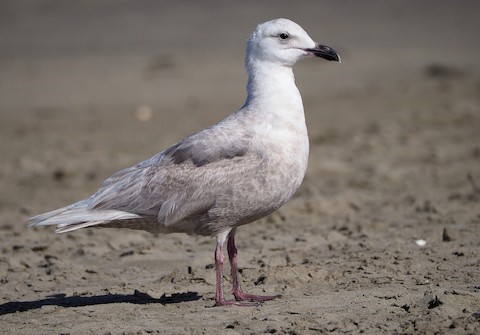
Glaucous-winged Gull, likely second-winter. (Morro Strand State Beach, Morro Bay, California; March 31, 2021.) © Aidan Brubaker
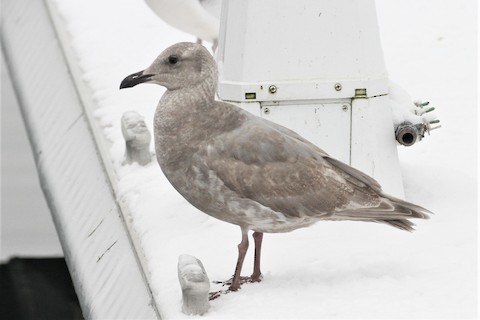
Glaucous-winged Gull, second-winter. (Barrie, Ontario; November 29, 2021.) © Garth V. Riley

Glaucous-winged Gull, second-winter. (Kitimat, British Columbia; February 5, 2022.) © Walter Thorne

Glaucous-winged Gull, second-winter—a notably pale individual. (South Jetty of the Siuslaw River Mouth, Oregon; April 23, 2021.) © Noah Strycker

Glaucous-winged Gull, likely second-summer. (Clover Point, Victoria, British Columbia; April 23, 2015.) © David M. Gascoigne
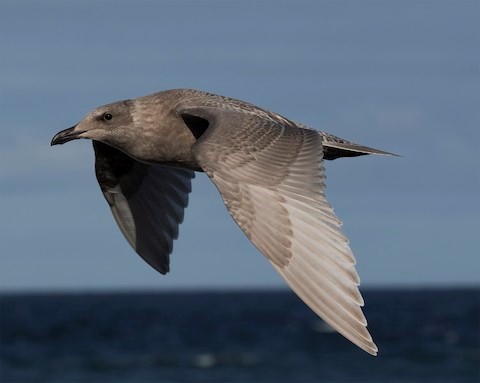
Glaucous-winged Gull, juvenile. (Gambell, St. Lawrence Island, Alaska; September 17, 2018.) © Gary Rosenberg

Glaucous-winged Gull, first-winter. (Morro Strand State Beach, Morro Bay, California; March 31, 2021.) © Aidan Brubaker
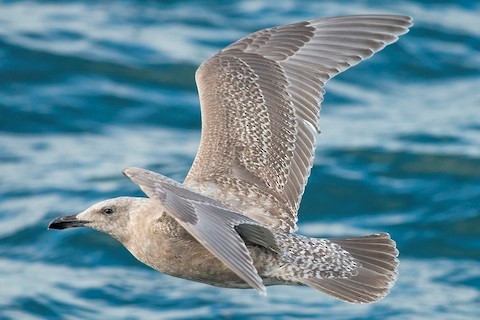
Glaucous-winged Gull, first-winter. (Offshore from Port Townsend, Washington; February 26, 2017.) © Bernardo Alps
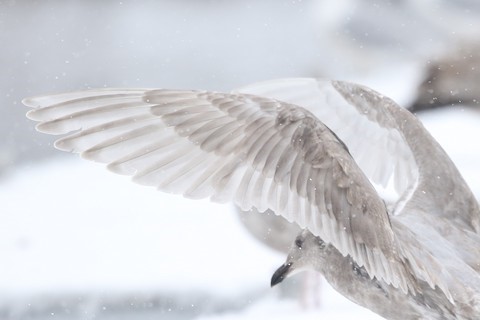
Glaucous-winged Gull, second-winter. (Barrie, Ontario; November 28, 2021.) © Nathan Hood
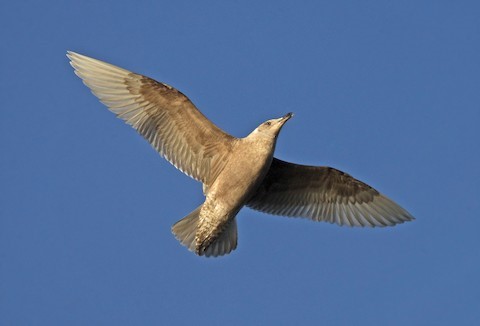
Glaucous-winged Gull, likely first-winter. (Bodega Bay, California; January 10, 2020.) © Matt Davis

Glaucous-winged Gull, first-winter. (Pickles Butte Landfill, Nampa, Idaho; April 9, 2011.) © Alex Lamoreaux

Glaucous-winged Gull, likely first-winter. (Point Pinos, California; January 29, 2018.) © Blake Matheson

Glaucous-winged Gull, likely second-winter, a dark individual. (Sandspit, British Columbia; October 25, 2015.) © Cameron Eckert

Glaucous-winged Gull, third-summer. (St. Paul Island, Alaska; May 22, 2015.) © Cory Gregory

Glaucous-winged Gull in breeding plumage showing typical wingtip color and pattern. (Anchor Point, Alaska; June 2, 2016.) © Lars Petersson
References
Alderfer, J., and J.L. Dunn. 2014. National Geographic Complete Birds of North America (Second Edition). National Geographic Society, Washington, D.C.
BirdLife International. 2018. Larus glaucescens. The IUCN Red List of Threatened Species 2018: e.T22694334A132543276. https://dx.doi.org/10.2305/IUCN.UK.2018-2.RLTS.T22694334A132543276.en. (Accessed April 11, 2022.)
Brazil, M. 2009. Birds of East Asia. Princeton University Press.
eBird. 2022. eBird: An online database of bird distribution and abundance. Cornell Lab of Ornithology, Ithaca, N.Y. http://www.ebird.org. (Accessed April 11, 2022.)
Garcia-del-Rey, E. 2011. Field Guide to the Birds of Macaronesia: Azores, Madeira, Canary Islands, Cape Verde. Lynx Editions, Barcelona.
Harrison, P. 1983. Seabirds: An Identification Guide. Houghton Mifflin, Boston.
Howell, S.N.G., and J.L. Dunn. 2007. Gulls of the Americas. Houghton Mifflin, Boston.
Howell, S.N.G., and S. Webb. 1995. A Guide to the Birds of Mexico and Northern Central America. Oxford University Press.
Olsen, K.M., and H. Larsson. 2003. Gulls of North America, Europe, and Asia. Princeton University Press.
Pyle, R.L., and P. Pyle. 2017. The Birds of the Hawaiian Islands: Occurrence, History, Distribution, and Status. Version 2 (January 1, 2017). http://hbs.bishopmuseum.org/birds/rlp-monograph/. B.P. Bishop Museum, Honolulu, Hawaii.
Sibley, D.A. 2014. The Sibley Guide to Birds (Second Edition). Alfred A. Knopf. New York.
Svensson, L., K. Mullarney, and D. Zetterström. 2009. Birds of Europe (Second Edition). Princeton University Press.
Xeno-Canto. 2022. Glaucous-winged Gull – Larus glaucescens. https://xeno-canto.org/species/Larus-glaucescens. (Accessed April 11, 2022.)
